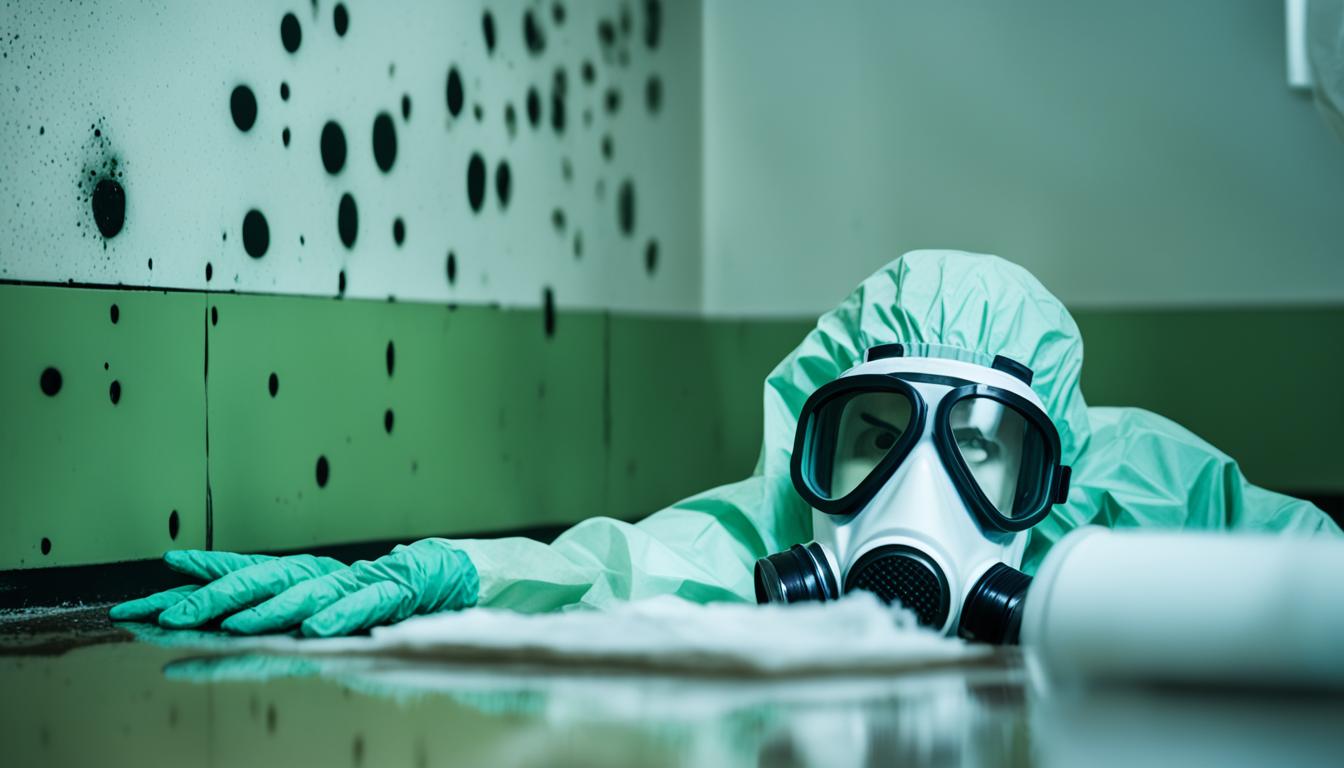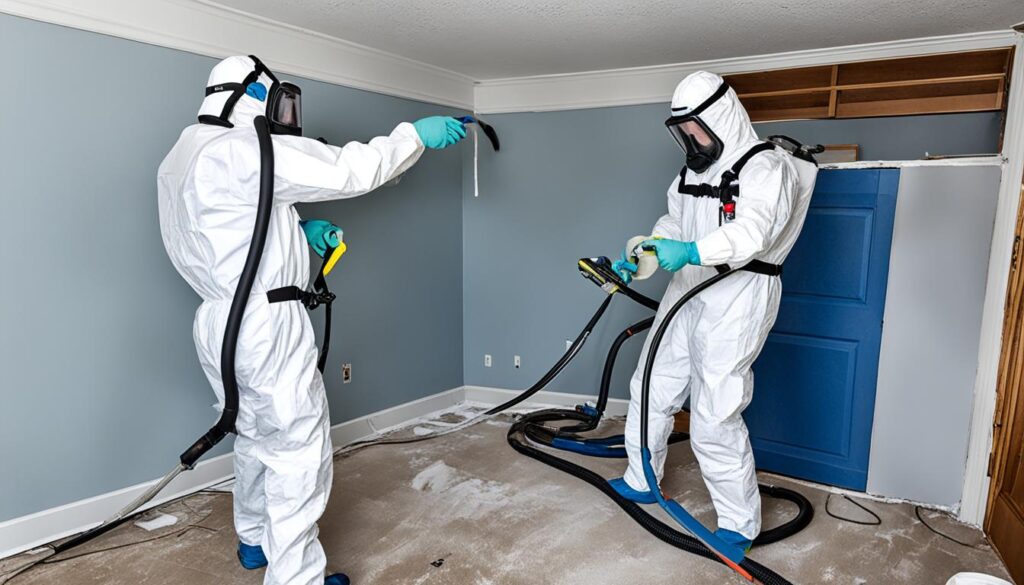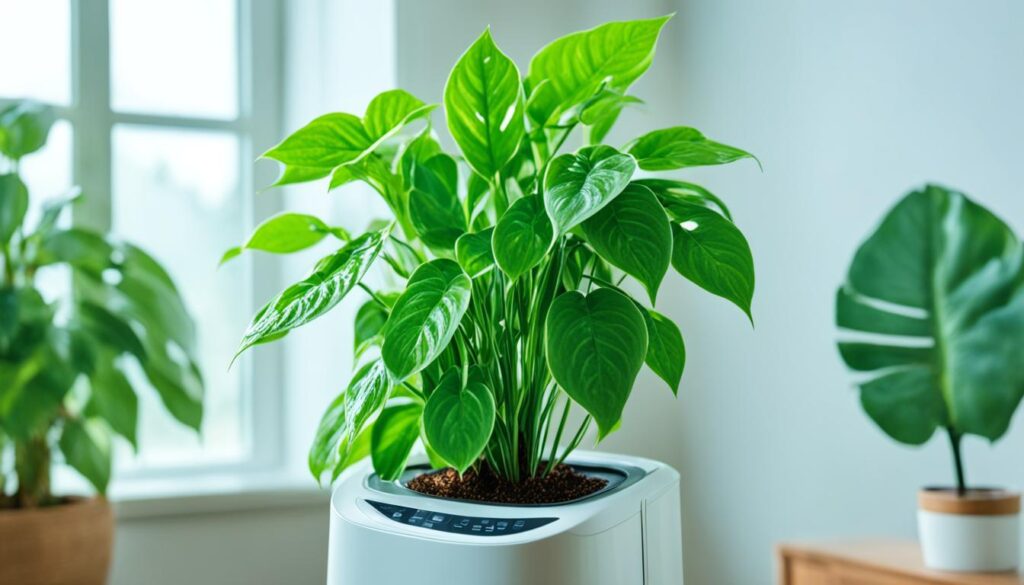
Effective Mold Remediation: How Do You Fix Mold?
Welcome to our comprehensive guide on mold remediation. If you’ve discovered mold in your home, you’re likely wondering how to fix the problem and eliminate mold for good. In this article, we will provide you with valuable insights, tips, and techniques for effectively removing mold and preventing its recurrence.
Mold removal can be a daunting task, but with the right knowledge and methods, you can successfully tackle this issue. From DIY mold removal tips to professional mold remediation processes, we’ve got you covered.
Before we dive into the specifics of mold remediation, it’s essential to understand the growth of mold and the potential dangers it poses. Mold can cause respiratory issues, allergic reactions, and even structural damage to your home if left untreated.
Now, let’s explore some key takeaways from this section:
Key Takeaways:
- Understanding how mold grows and the dangers it presents is crucial in addressing mold remediation effectively.
- Mold can have harmful effects on your health, causing respiratory problems and allergies.
- Identifying common areas where mold thrives can help in preventing its growth.
Now that we have a solid foundation, let’s move on to the DIY mold removal tips in the next section.
Understanding Mold Growth and Its Dangers
Before diving into mold remediation methods, it is crucial to understand the growth of mold and the potential dangers it poses to our health. Mold is a type of fungus that thrives in moist and warm environments. It reproduces by releasing spores into the air, which can easily spread and settle on various surfaces.
Mold can grow in virtually any area of your home where moisture is present. Common places include bathrooms, kitchens, basements, and areas with water leaks or high humidity levels. It often hides in hidden spaces such as behind walls, under carpets, or inside ventilation systems, making it difficult to detect.
Exposure to mold can have detrimental effects on our health. Inhalation of mold spores can trigger allergic reactions, respiratory problems, and worsen existing conditions such as asthma and allergies. Prolonged exposure to mold may even cause more severe health issues.
The Health Risks of Mold Exposure
Mold exposure can lead to various health risks, depending on the individual’s sensitivity and the type of mold present. Common symptoms of mold exposure include:
- Allergic reactions – sneezing, coughing, watery eyes, and skin irritation
- Respiratory problems – wheezing, shortness of breath, and chest tightness
- Headaches – frequent headaches or migraines
- Fatigue – feeling excessively tired or lethargic
In individuals with weakened immune systems or pre-existing respiratory conditions, mold exposure can pose a more significant risk. It may lead to severe infections or exacerbate chronic lung diseases.
If you notice any signs of mold growth in your home or experience unexplained health issues, it is essential to address the problem promptly and take appropriate measures for mold remediation.
By understanding the growth patterns and dangers of mold, you can take the necessary steps to prevent its proliferation and protect your health and well-being.
DIY Mold Removal Tips: How to Get Rid of Mold Yourself
For those who prefer to take matters into their own hands, DIY mold removal can be a cost-effective and empowering solution. By following the right techniques and precautions, you can successfully eliminate mold from your home. Here are some valuable tips to help you get started:
1. Identify the Source of Moisture
Mold thrives in damp environments, so it’s crucial to identify and address the source of moisture before starting the removal process. Check for leaks, condensation, or high humidity levels in areas prone to mold growth, such as bathrooms, kitchens, and basements. Fixing the moisture issue will help prevent future mold infestations.
2. Gather the Right Tools
Before you begin, gather the necessary tools to ensure a safe and effective DIY mold removal process. These may include:
- Protective gear: Wear gloves, goggles, and a mask to avoid exposure to mold spores.
- Plastic sheets or tarps: Use these to contain the affected area and prevent cross-contamination.
- Mold removal products: Choose safe and effective mold cleaners approved for home use. Look for products that are specifically designed to kill and remove mold.
- Scrub brushes: Use brushes with stiff bristles to scrub away mold from surfaces.
3. Take Precautions
Prior to starting the mold removal process, take necessary precautions to protect yourself and minimize the spread of mold spores. Close off the affected area by sealing doors, vents, and windows. Use plastic sheets or tarps to cover furniture and flooring, and ensure proper ventilation by opening windows and using fans. This will help contain the mold and prevent its spread to other areas of your home.
4. Clean and Remove Mold
When cleaning mold, it’s important to use safe and effective techniques. Here’s a step-by-step process for DIY mold removal:
- Wear protective gear, including gloves, goggles, and a mask.
- Thoroughly wet the moldy area to minimize the release of mold spores.
- Scrub the affected surfaces with a mold cleaner, using a scrub brush to remove mold stains.
- Rinse the area with clean water and wipe it dry.
- Dispose of any porous materials that cannot be cleaned effectively, such as carpeting, ceiling tiles, or drywall.
- Seal the moldy area in plastic bags and dispose of it properly.
- Thoroughly clean and dry all tools and equipment used in the removal process.
5. Prevent Future Mold Growth
After successfully removing mold from your home, it’s essential to implement preventive measures to avoid future infestations. Here are some tips to prevent mold growth:
- Control humidity levels: Use dehumidifiers or air conditioners to keep indoor humidity below 50%. Repair any leaks promptly to prevent moisture buildup.
- Ventilate properly: Ensure adequate ventilation in bathrooms, kitchens, and other moisture-prone areas. Use exhaust fans or open windows to improve air circulation.
- Inspect regularly: Regularly inspect your home for signs of water damage, leaks, or mold growth. Address any issues promptly to prevent further damage.
- Keep surfaces dry: Wipe down wet surfaces, such as countertops and bathroom fixtures, to prevent mold growth.
- Use mold-resistant products: Choose mold-resistant construction materials, such as drywall and paint, to create a more mold-resistant environment.
By following these DIY mold removal tips and implementing preventive measures, you can effectively eliminate mold from your home and safeguard your living environment.
“Taking the right precautions and following safe DIY mold removal techniques is crucial for successful mold eradication.” – [Your Name]
Recommended Tools for DIY Mold Removal
| Protective Gear | Plastic Sheets or Tarps | Mold Removal Products | Scrub Brushes |
|---|---|---|---|
| Gloves | Plastic sheets/tarps | Mold cleaners | Stiff-bristled brushes |
| Goggles | |||
| Mask |
The Mold Remediation Process: Professional Methods for Mold Removal
When mold infestations are severe or widespread, it is essential to seek professional help to ensure effective mold removal. Professional mold remediation services employ specialized techniques and follow a systematic process to eradicate mold from your home.
Here is an overview of the mold remediation process used by experts:
- Initial Assessment: Mold removal experts will conduct a thorough inspection of your property to identify the extent of the mold infestation. They will also locate the source of moisture that led to the mold growth.
- Containment: To prevent cross-contamination, professionals will create a containment area using barriers and negative air pressure systems. This ensures that mold spores do not spread to unaffected areas during the removal process.
- Removal of Affected Materials: Damaged materials such as drywall, carpeting, or insulation that cannot be effectively cleaned will be safely removed and disposed of to eliminate the source of mold growth.
- Clean-Up: Mold remediation experts will thoroughly clean all surfaces and belongings affected by mold using professional-grade products and techniques. This step ensures that mold spores are completely eliminated and prevents future regrowth.
- Air Filtration: High-efficiency particulate air (HEPA) filtration systems will be used to capture airborne mold spores during the cleaning process, improving air quality and reducing the risk of respiratory issues.
- Final Inspection: After the mold removal process is complete, professionals will conduct a final inspection to ensure that all traces of mold have been successfully removed. They may also provide recommendations for preventing future mold growth.
By hiring a mold remediation service, you can benefit from the expertise of mold removal experts who are trained in professional mold removal techniques. They have the necessary tools, knowledge, and experience to effectively address severe mold infestations, safeguarding your home and family from potential health risks.

Having professionals handle the mold remediation process also saves you time and effort, allowing you to focus on other important aspects of your life. The expertise of mold removal experts ensures a comprehensive and thorough mold removal process, providing you with peace of mind and a mold-free living environment.
Preventing Mold Growth: Techniques for Mold Prevention
To ensure a mold-free environment in your home, it is essential to implement effective techniques that discourage mold growth. By taking proactive measures, you can prevent the development of mold and protect your health and property. This section provides valuable insights and strategies for preventing mold, including the use of proper ventilation, managing humidity levels, utilizing mold-resistant construction materials, and maintaining regular inspections and cleaning routines.
Proper Ventilation
One of the key mold prevention techniques is ensuring proper ventilation in your home. Proper airflow helps to reduce moisture levels and prevent the buildup of condensation, which can contribute to mold growth. Consider the following ventilation practices:
- Open windows and doors regularly to improve air circulation.
- Install exhaust fans in kitchens, bathrooms, and laundry rooms to remove excess moisture.
- Use a dehumidifier in areas prone to high humidity, such as basements or crawl spaces.
Humidity Control
Controlling indoor humidity is crucial in mold prevention. Mold thrives in environments with high humidity levels, so managing moisture is essential. Here are some effective humidity control techniques:
- Keep indoor humidity levels between 30% and 60%. Use a hygrometer to monitor humidity and a humidifier or dehumidifier to adjust levels accordingly.
- Fix any leaks or water damage promptly to prevent the accumulation of moisture.
- Avoid overwatering indoor plants, as excessive moisture can promote mold growth.
Mold-Resistant Construction Materials
Utilizing mold-resistant construction materials can significantly contribute to mold prevention. These materials are designed to resist moisture absorption and inhibit mold growth. Consider the following:
- Use mold-resistant drywall or sheetrock in areas prone to moisture, such as bathrooms, kitchens, and basements.
- Choose mold-resistant paint or coatings for walls and ceilings.
- Opt for moisture-resistant flooring materials, such as ceramic tiles or vinyl, in wet areas.
Regular Inspections and Cleaning Routines
Maintaining regular inspections and cleaning routines can help identify and prevent mold growth before it becomes a major problem. Here are some practices to incorporate:
- Inspect your home regularly for any signs of moisture or water damage, such as leaks, condensation, or musty odors.
- Keep your home clean and dry, paying extra attention to areas prone to moisture or humidity, such as bathrooms, kitchens, and basements.
- Ensure proper drainage around your home, directing water away from the foundation.
By implementing these mold prevention techniques, you can create a healthier environment for you and your family while safeguarding your home from the damaging effects of mold growth.

Conclusion
In conclusion, mold remediation is an essential process in ensuring a safe and healthy living environment. Whether you decide to tackle mold removal yourself or opt for professional assistance, understanding the steps involved and implementing preventive measures is crucial for fixing mold and preventing its reoccurrence.
When it comes to mold removal, it is important to consider the severity of the infestation and your level of expertise. DIY mold removal can be effective for minor cases, but for extensive mold growth or if you are unsure, it is advisable to hire a professional mold removal service. Their expertise and experience will ensure a thorough and safe removal process.
To prevent mold growth in the future, it is important to address the underlying causes. Regularly inspect your home for moisture issues, such as leaks or high humidity levels, and promptly fix them. Implementing proper ventilation, utilizing mold-resistant construction materials, and maintaining a clean and dry environment will go a long way in preventing mold formation.
If you require expert assistance with mold assessment, prevention, and remediation, contact Fix Mold Miami. As Florida’s highest-rated mold removal service, they offer comprehensive in mold assessments, advanced mold prevention techniques, and effective mold remediation solutions. Call 305-465-6653 to ensure a mold-free and healthier living space.
FAQ
How does mold develop in a home?
Mold develops in homes where there is excess moisture and a suitable environment for its growth. It thrives in areas with high humidity levels, water leaks, poor ventilation, or flooding.
What are the potential health risks of mold exposure?
Mold exposure can lead to various health issues, including allergic reactions, respiratory problems, aggravated asthma symptoms, sinusitis, and even infections in individuals with weakened immune systems.
Can I remove mold myself?
Yes, you can remove mold yourself if the affected area is small and the mold growth is minimal. However, it is important to take necessary precautions, such as wearing protective gear and using appropriate cleaning products, to ensure safe removal.
What is the best method for DIY mold removal?
The best method for DIY mold removal involves using a solution of bleach and water, or an antimicrobial cleaner specifically designed for mold. Scrub the affected area thoroughly, ensuring all visible mold is removed, and then dry the area completely.
When should I hire a professional mold removal service?
It is advisable to hire a professional mold removal service if the mold infestation is extensive, covers a large area, or if you are unable to effectively remove the mold using DIY methods. Professionals have the expertise and equipment needed to tackle severe mold problems.
What is the mold remediation process followed by professionals?
The mold remediation process involves several steps, including assessing the extent of mold damage, containing the affected area, removing mold-infested materials, cleaning and disinfecting surfaces, and implementing preventive measures to inhibit future mold growth.
How can I prevent mold growth in my home?
To prevent mold growth, ensure proper ventilation in bathrooms, kitchens, and other high-moisture areas. Use dehumidifiers to control indoor humidity levels, fix any water leaks promptly, and clean and dry areas prone to moisture regularly.




